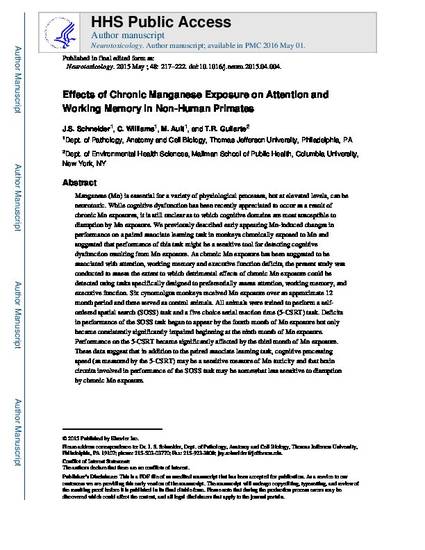
Manganese (Mn) is essential for a variety of physiological processes, but at elevated levels, can be neurotoxic. While cognitive dysfunction has been recently appreciated to occur as a result of chronic Mn exposures, it is still unclear as to which cognitive domains are most susceptible to disruption by Mn exposure. We previously described early appearing Mn-induced changes in performance on a paired associate learning task in monkeys chronically exposed to Mn and suggested that performance of this task might be a sensitive tool for detecting cognitive dysfunction resulting from Mn exposure. As chronic Mn exposure has been suggested to be associated with attention, working memory and executive function deficits, the present study was conducted to assess the extent to which detrimental effects of chronic Mn exposure could be detected using tasks specifically designed to preferentially assess attention, working memory, and executive function. Six cynomolgus monkeys received Mn exposure over an approximate 12 month period and three served as control animals. All animals were trained to perform a self-ordered spatial search (SOSS) task and a five choice serial reaction time (5-CSRT) task. Deficits in performance of the SOSS task began to appear by the fourth month of Mn exposure but only became consistently significantly impaired beginning at the ninth month of Mn exposure. Performance on the 5-CSRT became significantly affected by the third month of Mn exposure. These data suggest that in addition to the paired associate learning task, cognitive processing speed (as measured by the 5-CSRT) may be a sensitive measure of Mn toxicity and that brain circuits involved in performance of the SOSS task may be somewhat less sensitive to disruption by chronic Mn exposure.
Available at: http://works.bepress.com/toms-guilarte/2/

This article has been peer reviewed. It is the authors' final version prior to publication in NeuroToxicology, Volume 48, May 2015, Pages 217-222.
The published version is available at DOI: 10.1016/j.neuro.2015.04.004. Copyright © Elsevier